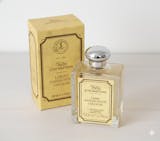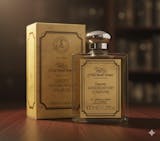The History of Shaving Brushes

Photo by nejron on Depositphotos
My four-year-old brain was absolutely fascinated by this tool—an oddly shaped, fuzzy-looking device called a vintage shaving brush. I would gaze on in wonder during one of my rare forays into my parents' bathroom in my childhood home. Theirs looked so different than the bathroom I shared with my sister—it was much cleaner, to be sure, but it also had several other things. The Aqua-Fresh was replaced with whitening toothpaste, colorful kiddie dental floss was transformed into a no-nonsense monochrome thread dispenser, and then—the shaving brush.
I had no concept of an old-fashioned vintage shaving brush, no comparison point—it was unlike anything I had ever seen. While my own innocent history with the shave brush starts here, the history of shaving brushes is a far more exotic and dramatic story—one steeped in aristocratic excesses, deadly outbreaks of disease, and over-reliance on a particularly ornery animal: the badger.
- Origins of the Shaving Brush
- How were Traditional Shaving Brushes Made?
- What Kind of Badger Hair Shaving Brushes are There?
- What Other Animal Hair was Used to Make Brushes?
- The Horse Hair Anthrax Scare
- Are Badgers Killed to Make Shaving Brushes?
- How are Modern Shaving Brushes Made?
- What are Modern Shaving Brushes Made From?
- The Resurgence of the Shaving Brush
Origins of the Shaving Brush
 Born from the aristocracy’s pursuit of refinement, the shaving brush became the hallmark of a proper shave.
Born from the aristocracy’s pursuit of refinement, the shaving brush became the hallmark of a proper shave.
Photo by dgem22 on Depositphotos
The antique shaving brush may not have quite the long and storied past of the razor itself—most of human history has seen men (and women) shave dry without the use of shaving foam or shaving soaps, or shaving cream spread around facial hair with a thick, rich lather (or shave with sea sponges when using water or soap).
However, as with any tool that was created for grooming, the aristocracy was (unsurprisingly) at the forefront of the invention.
Modern thinking, particularly modern attitudes towards beards and five o'clock shadow, began around the Enlightenment in Europe. While scholars still debate the exact time period of the first shaving brush, it is commonly accepted that shaving brushes began to appear sometime between 1648 and 1750.
While the first written reference1 to shaving brushes appears in France in the mid-18th century, a 1648 Dutch painting2 clearly depicts a shaving brush resting on the table of a barber-surgeon.
The beard underwent a transformation during the Enlightenment, shifting from a Medieval conception associated with strength and masculinity to one perceived as belonging to the lower classes. By the time of the Enlightenment, beards were associated with peasants, soldiers, and priests. Aristocrats, they believed, were above such filthiness and set the fashion of having a face without a beard.
Shaving brushes were created in these circles, with barbers having to invent new tools to ensure that not only were the nobility happy with their daily shaves, but that they felt that their skin was not being marred by the scraping of sharp metal over their faces each morning.
Why was the Shaving Brush Invented?
Shaving brushes were invented to help care for the sensitive skin of the nobles who initially used them. Wet shavers have long used shaving creams or shaving soap to loosen facial hair, allowing the skin underneath to become moisturized and more pliable for the incoming razor.
However, this was often done with one's own hands or a sea sponge—and for anyone who knows anything about 18th-century nobility, dirtying one's hands would simply not do.
Hence, the shaving brush: a hands-free way of applying shaving soap to one's face. However, while the original purpose of shaving brushes may seem mundane, their practical usefulness adds to their fame.
The reason that shaving brushes are a staple of wet shavers' bathroom cabinets worldwide is that they are more than a simple tool for keeping your hands clean—they were also invented to create a fine lather.
The animal hair shaving brushes that were initially used (and are still generally used to this day) retain water, allowing the cream or soap to mix into a lather—the richer the lather, the less damage is done to the face underneath.
Over time, the shave brush became a status symbol (as did most things with the aristocracy, to be fair), and owning one in the 18th century was a way to show your contemporaries how rich and important you were.
How were Traditional Shaving Brushes Made?
Shave brushes are composed of two simple parts: the handle and the brush. The brush itself is traditionally made with badger hair, although they have also been made with boar bristle or a horse's mane.
How are the Handles of Shaving Brushes Made?
The handle is not made of traditional materials; when shaving brushes were initially invented, it was likely a wooden handle, as it was the most plentiful and malleable substance on hand that would work well with shaving brush knots.
However, once the shave brush skyrocketed in popularity and became a status symbol, the handle material became another way the nobility could showcase their wealth. There have been historical accounts3 of handles made of crystal, gold, ivory, horn, or even porcelain.
Why are Shaving Brushes Made From Pure Badger Hair?
 Badger hair set the standard for shaving brushes with its superb water retention.
Badger hair set the standard for shaving brushes with its superb water retention.
Photo by The New York Public Library on Unsplash
Badger shaving brushes are the original vintage shave brush, and they remain the most popular today, especially among wet shaving enthusiasts. Badger hair brushes were first popularized around the same time as the shaving brush, for several reasons.
The first was that the badger was a fairly common woodland creature in Europe, with a vast diaspora at the time, and was not necessarily hunted by European nobles for anything other than sport.
However, badger hair was discovered (presumably during the development of the shaving brush) to be excellent at retaining water and creating a good lather for wet shaving. Let's not think too much about what they were doing with badgers to figure this out.
What Kind of Badger Hair Shaving Brushes are There?
Badger hair brushes were soon the norm and were classified into four main tiers of badger brushes:
-
Pure Badger
Pure Badger hair is considered the most common type of shaving brush hair, taken from the underbelly of the badger and regarded as a lower-grade, dark-colored, and somewhat stiff option.
-
Best Badger
The Best Badger brushes are rarer and more expensive than pure badger brushes, producing a finer lather that is softer and lighter in color, and retaining the warmth and hydration of the lather better than lower-grade brushes.
-
Super Badger
Super Badger brushes are a premium grade just below Silvertip. Made from fine, densely packed hairs often bleached for silvery tips, they offer exceptional softness, strong water retention, and a rich, creamy lather. While not as rare as Silvertip, they provide a luxurious, gentle shave at a more accessible price.
-
Silvertip Badger
Silvertip Badger hair is considered the top-of-the-line for shaving brushes. The hair is naturally white, soft, and fluffy, making it the ideal choice for water retention and lathering capacity.
Boar brushes, horse hair shaving brushes, and synthetic shaving brushes make up the remainder of traditional shaving brushes.
What Other Animal Hair was Used to Make Brushes?
-
Boar bristle brushes
A boar brush is tougher, which can have the added benefit of exfoliating the skin during shaving, but the downside is that boar bristles can be more brittle and prone to damage than badger hair.
-
Horse hair brushes
Well, horse hair has a unique history of its own when it comes to the shaving brush. Let's get into it.
The Horse Hair Anthrax Scare
 Robert Koch, a Virologist who discovered anthrax.
Robert Koch, a Virologist who discovered anthrax.
Photo by Gordon Johnson from Pixabay
No history of shaving brushes would be complete without discussing the outbreak of anthrax4 related to shaving brushes in the early 20th century.
It should come as no surprise that the sanitary conditions of the First World War were among the worst in modern history. Soldiers had to deal with the 1918 Spanish Flu, typhus, malaria, encephalitis, and, it turns out, anthrax. However, the anthrax outbreak didn't come from the terrible conditions in the trenches, but from the shaving brushes given to the soldiers.
The clean-shaven face became an important facet of 20th-century Europe—a far cry from the exclusive affectation of the stuffy nobles of the Enlightenment era. By the 1900s, it was the norm for young men in Great Britain, France, and Germany to start their days by lathering up with shaving cream in mugs with their government-issued brushes, then having a morning shave before the horrors of the Great War began anew. The higher-ups of each army also stated that the potentially life-saving gas masks, which were ubiquitously used in the trenches, would provide an airtight fit for a clean-shaven man but not for a bearded one.
In 1914, Russia was the largest supplier of badger hair for making shaving brushes in Europe, whose trade to its Triple Entente partners had been cut off by Germany's iron wall through Central Europe and its liberal use of the newly invented U-boat to disrupt shipping lanes. With the regular supply of badger hair thus cut off, the British and French armies were susceptible to deception.
The so-called badger hair shaving brush that was given to each soldier as part of his shaving kit in World War I was actually made of knock-off horse hair4 from dubious markets. While horse hair is usually not necessarily risky (in all fairness, horses do carry a higher chance of carrying anthrax, as they are herbivores when compared to the omnivorous badger or boar), the badger hair counterfeiters didn't necessarily make the brushes from their best stock.
What is Anthrax, and Will It Show Up in a Shaving Brush?
As an aside, you may remember anthrax (as I do) as that terrifying substance that was found in envelopes sent to members of Congress a week after 9/11. Anthrax, quite simply, is a bacteria-based infection that manifests on the skin and in the lungs. It is a highly dangerous disease, with a mortality rate of 20-80% if left untreated (and it most certainly was left untreated in World War I).
When the men in the British trenches saw the horrific infections on the faces of their soldiers, they were convinced of some devious plot by the Germans. Public health officials traced the anthrax outbreak to the hastily acquired brushes and, slowly but surely, the complaints about a new German biological weapon disappeared.
However, humanity being humanity, some despot potentially took inspiration from this incident and developed anthrax into the biological weapon it is today.
These days, there is zero chance of contracting anthrax from tainted shaving brushes—so you really don't have to worry about that unless you decide to use one that was made a hundred years ago. In that case, it's really on you.
Are Badgers Killed to Make Shaving Brushes?
In the early days of shaving brushes, badger hair was typically obtained through hunting. As it was an invention by the aristocracy, badger hair was usually harvested through this favored pastime of the elite in Europe during this era. A badger brush was a by-product of these hunts, with their pelts and furs being used for several fashionable garments, including the Highland Scottish sporran.
A modern badger brush will indeed be made from a badger whose hair has been harvested during a cull. Most badger hair comes from China, where a large badger population has a significant impact on agriculture. From time to time, badger culls are done, and the badger brush is the result.
How are Modern Shaving Brushes Made?
 Modern shaving brushes blend time-honored craftsmanship with updated materials.
Modern shaving brushes blend time-honored craftsmanship with updated materials.
Photo by info.annaburek.com on Depositphotos
One thing that has not changed significantly over time is the method used to make shaving brushes. While the materials for the brush and the handle may have changed over time, the connection between the two parts has remained the same.
This is where you'll find technical terms like 'knot' and 'loft'. While there are shaving brush guides that provide greater detail, the brush maker ties off bundles of pure badger hairs (or synthetic fibers) into the traditional concave design of the brush and cuts off the bottom, using a strong epoxy glue to secure the bristles to the handle.
Based on the specifications of the brush or material used, the brush maker will also adjust the width of the spread (the knot) and the vertical length of the brush (the loft).
What are Modern Shaving Brushes Made From?
While there are many fine brushes available today, the modern shaving brush is still made with badger hair—and remains the gold standard.
Wet shavers prefer synthetic brushes over badger hair shaving brushes, partially to curb animal use in human grooming (synthetic brushes are a vegan alternative to badger brushes) and also to harness technology to the wet shavers' benefits. Some wet shaving brands are producing synthetic materials with such high quality that you would be hard-pressed to tell the difference between the highest quality grades of badger hair and synthetic fibers. Sometimes they are preferred for their ability to produce a thick, creamy lather, their softness, and their tendency to dry faster than natural hair.
What is the Difference Between Synthetic Bristles and Badger Bristles?
A modern shaving brush using synthetic materials is very durable, especially when the brush is being used every day, compared to badger hair. Synthetic shaving brushes also have bristles that dry faster than those made from badger or other animal hair, reducing the risk of water damage to the brush during cleaning and storage.
However, just because synthetic shaving brushes are available doesn't mean that you can't find badger hair or boar brushes around for the same reasons that you will always be able to see straight razors, along with an electric razor—the traditional will always be in style.
You may have a more difficult time finding gold-plated handles.
The Resurgence of the Shaving Brush
While the shaving brush has never really gone away, it has undoubtedly been given a run for its money in terms of popularity in the era of safety razors, electric razors, and the science going into shaving cream.
The need for a high-end brush dipped in the latter half of the 20th century, much to the detriment of men's faces everywhere. However, as my four-year-old discovery of shaving brushes illustrates, the shaving brush has always remained on the periphery of men's grooming, even if it no longer holds the place of pride it once did in the perfumed salons and bathing chambers of 18th-century France.
However, the last few years have seen a massive jump in popularity5 in traditional shaving paraphernalia—straight razors have come back in vogue, the shaving process has been refurbished into a fine art, and men's grooming has slowly but surely been integrated as an accepted form of self-care where it had been seen as a chore.
Whether you prefer natural hair or synthetic bristles, the history of shaving brushes continues to this day. And hey, the next time a four-year-old asks you what that weird, bristly thing is sitting in your bathroom cabinet, you have got a hell of a story for him.
Related Articles
The Complete Guide to Shaving Brushes 2025
How to Clean and Store a Shaving Brush
Guide to Using Shaving Soap for Lathering
References
- Peterkin, A. (2014). One Thousand Beards: A Cultural History of Facial Hair. Arsenal Pulp Press. https://books.google.co.za/books?id=7pdN3PnqOwMC
- Koedijck, I. (c. 1649/1650). Barber-Surgeon tending a Peasant’s Foot [Painting]. Rose-Marie and Eijk van Otterloo Collection, Museum of Fine Arts Boston. Wikimedia Commons. https://commons.wikimedia.org/wiki/File:Isaack_Koedijck-barber-surgeon-tending-a-peasants-foot.jpg
- Shave brush. (n.d.). ChemEurope. https://www.chemeurope.com/en/encyclopedia/Shave_brush.html
- Becker, R. (2017, May 2). That antique shaving brush could give you face anthrax. The Verge. https://www.theverge.com/2017/5/1/15507992/anthrax-shaving-brush-face-skin-world-war-i-outbreak-cdc
- Wet Shave Market (2025 - 2030). (n.d.). Grand View Research. https://www.grandviewresearch.com/industry-analysis/wet-shave-market
































Leave a comment